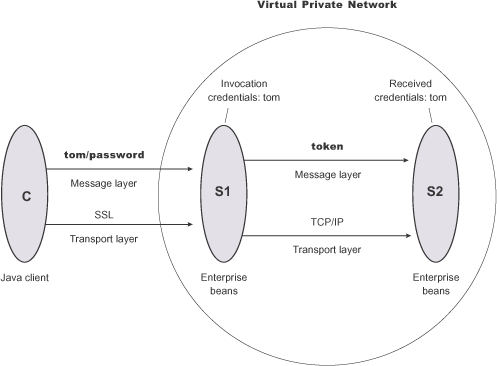Example 4: Configure TCP/IP transport using a virtual private network
This scenario illustrates the ability to choose TCP/IP as the transport when it is appropriate. In some cases, when two servers are on the same virtual private network (VPN), it can be appropriate to select TCP/IP as the transport for performance reasons because the VPN already encrypts the message.

- Configure client C for message layer authentication with an SSL transport.
- Point the client to the sas.client.props file.
(dist) Use the com.ibm.CORBA.ConfigURL=file:/C:/was/properties/sas.client.props property. All further configuration involves setting properties within this file.
(iseries) Use the com.ibm.CORBA.ConfigURL=file:/ profile_root/properties/sas.client.props property. The profile_root variable is to the specific profile you are working with. All further configuration involves setting properties within this file.
- Enable SSL.
In this case, SSL is supported but not required.com.ibm.CSI.performTransportAssocSSLTLSSupported=true, com.ibm.CSI.performTransportAssocSSLTLSRequired=false
- Enable client authentication at the message layer. In this case, client authentication is supported but not required. com.ibm.CSI.performClientAuthenticationRequired=false, com.ibm.CSI.performClientAuthenticationSupported=true
- Use the remaining defaults in the sas.client.props file.
- Point the client to the sas.client.props file.
- Configure the S1 server. In the console, the S1 server is configured for incoming requests to support message-layer client authentication and incoming connections to support SSL without client certificate authentication. The S1 server is configured for outgoing requests to support identity assertion.
It is possible to enable SSL for inbound connections and disable SSL for outbound connections. The same is true in reverse.
- Configure S1 for incoming connections.
- Disable identity assertion.
- Enable user ID and password authentication.
- Enable SSL.
- Disable SSL client certificate authentication.
- Disable identity assertion.
- Configure S1 for outgoing connections.
- Disable identity assertion.
- Enable user ID and password authentication.
- Disable SSL.
- Disable identity assertion.
- Configure S1 for incoming connections.
- Configure the S2 server.
In the console, the S2 server is configured for incoming requests to support identity assertion and to accept SSL connections. Configuration for outgoing requests and connections are not relevant for this scenario.
- Disable identity assertion.
- Enable user ID and password authentication.
- Disable SSL.
- Disable identity assertion.
Related tasks